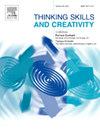Promoting group creative performance by enhancing motivation to cooperate: Mechanisms at the behavioral and neural levels
IF 3.7
2区 教育学
Q1 Social Sciences
引用次数: 0
Abstract
Close collaboration is widely acknowledged to be imperative for fostering excellent creative performance and ensuring group success. However, limited research has been conducted on motivating group members to collaborate closely in creative tasks. This study aimed to examine whether enhancing motivation to cooperate could effectively facilitate collaboration and enhance performance in creative groups, while simultaneously exploring the underlying mechanisms associated with these effects. A total of 108 participants were randomly assigned to dyads to work together on an open ended idea generation task. Following previous studies, motivation to cooperate was manipulated using group-(high motivation to cooperate) or individual-based (low motivation to cooperate) reward structures. Ratings of creative performance, indicators of collaboration quality at the behavioral level, and hemodynamic interbrain synchrony (IBS) were compared between the two experimental conditions, and the mediating effect of the members’ characteristics was tested. The results showed that groups with high motivation to cooperate exhibited significantly higher originality, higher flexibility, higher willingness to cooperate, lower perceived competition, and a significant increase in interbrain synchrony in the prefrontal cortex than groups with low motivation to cooperate. The results demonstrated that when promised a group-based reward, group members engaged in closer collaboration and exhibited higher levels of originality and flexibility in their work. The implementation of motivation to cooperate is particularly effective for groups comprising individuals with low or medium openness. Furthermore, cognitive control appeared to play a crucial role in augmenting the quality of cooperation.
通过加强合作动机来促进群体创造性表现:行为和神经层面的机制
密切的合作被广泛认为是培养优秀的创造性表现和确保团队成功的必要条件。然而,关于激励团队成员在创造性任务中密切合作的研究有限。本研究旨在探讨加强合作动机是否能有效地促进创造性群体的合作和提高绩效,同时探讨与这些影响相关的潜在机制。总共108名参与者被随机分成两组,一起完成一个开放式的创意生成任务。根据以往的研究,合作动机被操纵为基于群体(高合作动机)或基于个人(低合作动机)的奖励结构。比较两种实验条件下的创新绩效评分、行为层面的协作质量指标和血流动力学脑间同步(IBS),并检验成员特征的中介作用。结果表明,高合作动机组比低合作动机组表现出更高的独创性、更强的灵活性、更高的合作意愿、更低的竞争感知,且前额叶皮层的脑间同步显著增加。结果表明,当承诺以团队为基础的奖励时,团队成员会更紧密地合作,在工作中表现出更高的独创性和灵活性。对于开放性低或中等的个体组成的群体,合作动机的实施特别有效。此外,认知控制似乎在提高合作质量方面起着至关重要的作用。
本文章由计算机程序翻译,如有差异,请以英文原文为准。
求助全文
约1分钟内获得全文
求助全文
来源期刊

Thinking Skills and Creativity
EDUCATION & EDUCATIONAL RESEARCH-
CiteScore
6.40
自引率
16.20%
发文量
172
审稿时长
76 days
期刊介绍:
Thinking Skills and Creativity is a new journal providing a peer-reviewed forum for communication and debate for the community of researchers interested in teaching for thinking and creativity. Papers may represent a variety of theoretical perspectives and methodological approaches and may relate to any age level in a diversity of settings: formal and informal, education and work-based.
 求助内容:
求助内容: 应助结果提醒方式:
应助结果提醒方式:


